documentation and help
Last revision: 2007-11-21
1. Description
1.1. Concept
1.2. Input
1.2.1. Supported Protocols
1.3. Plotting Scheme
1.4. Features
2. Usage
2.1. Command Line
2.2. User Interface and Controls
2.2.1. Control Panel
2.2.2. InetVis Display
2.2.2.1. Navigation via Mouse Controls
2.2.2.2. Navigation via Keyboard Controls
2.2.2.3. Other Keyboard Controls
2.2.3. Plotter Settings Dialogue
2.2.4. Reference Frame Settings Dialogue
2.3. Usage Notes
2.3.1. Tool tips as Helpful Hints
2.3.2. Applying Settings
2.3.3. Setting the Home Network Range Before Playback
2.3.4. Setting Address Ranges with CIDR Notation
2.3.5. Recording
2.3.5.1. Record to Capture File
2.3.5.2. Taking an Image Snapshot
2.3.5.3. Dumping Rendered Frames to Image Files
2.3.5.4. Location of Recorded Files
2.3.6. Administrator Privileges
3. Requirements and Performance
3.1. Operating Platform
3.2. Requirements to Run Linux Binary
3.3. Requirements to Run Windows Binary
3.4. Minimum System Specification
3.5. Typical Performance
4. Known Issues
4.1 Stability and Performance
4.2 Limitations and Feature Wish List
5. Building and Developing InetVis
5.1. Build Requirements for Linux (Ubuntu/Debian)
5.2. Build Requirements for Windows
5.3. Recommend Development Tools
6. Acknowledgement
7. Disclaimer
8. Contact
InetVis - Internet Visualization
version: 0.9.5
release date: 2007/11/21
InetVis is a 3-D scatter-plot visualization for network traffic. It's more or less like a media player, but for network traffic. At the moment its just an academic toy for reviewing packet capture files, but may be useful in other endeavours. For example, InetVis has been used to verify and critique the accuracy of scan detection algorithms in the Snort IDS and Bro IDS.
The original source of inspiration for InetVis is the "The Spinning Cube of Potential Doom" (by Stephen Lau). Whilst many other network visualizations employ lines as a metaphor for connection, the 3-D scatter-plot of points proves to scale well with larger volumes of data. The visualization makes network scanning and port scanning readily evident as horizontal and vertical lines respectively. InetVis offers numerous extensions that enhance the original basic concept (see 1.4. Features). For a description of "The Spinning Cube of Potential Doom" see:
InetVis visualizes packet captures of network traffic using Libpcap to either
Tcpdump, Wireshark and Snort are examples of applications can use the Libpcap file format.
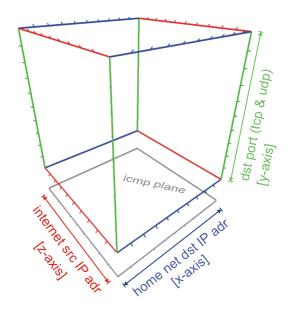
./inetvis
The display pane and control panel are in separate windows, with a plotter settings dialogue and reference frame settings dialogue accessed via the 'view' menu of the control panel
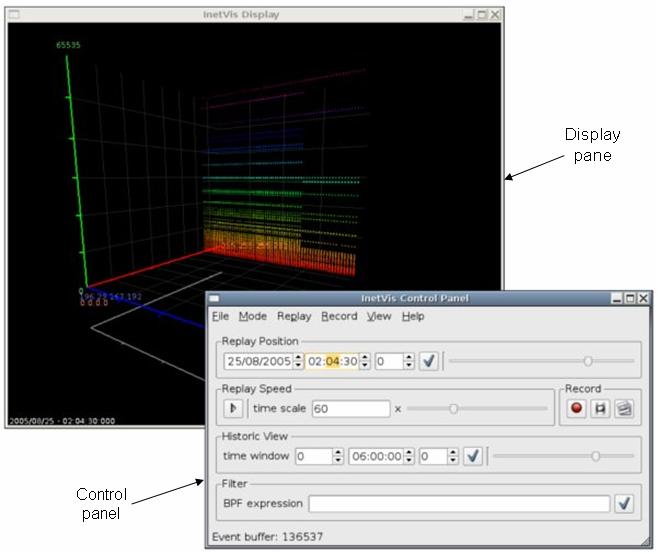
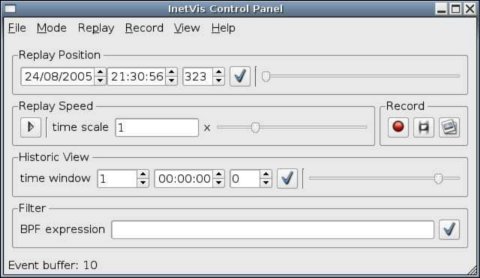
The visualization display pane.
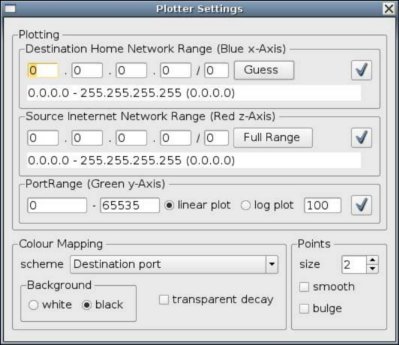
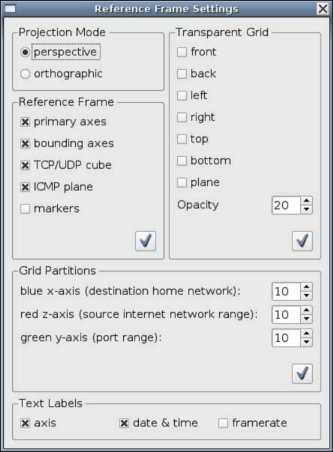
Majority of the controls, buttons and fields in the GUI provide tool tips to help explain their function and usage. Tool tips can be seen by hovering the mouse cursor over the GUI component in question.
Many of the settings are grouped together and require the user to click the apply button (button with a tick icon) once they are ready to apply the new settings.
After opening a file, set the home network address (in Plotter Settings dialogue) to scale the data along the blue axis - otherwise all traffic is rendered in a narrow single band with respect to the x-axis. A 'guess' button can help infer this home network range by checking the destination addresses contained within the file. In the case of monitoring the local network interface (live packet capture), the application will automatically retrieve the home network address from Libpcap.
Setting the address ranges entails using 'dots-slash' (CIDR) notation to specify network sub-domains. For example 192.168.0.0/24 is the network with address 192.168.0.0, subnet mask 255.255.255.0, giving the network range 192.168.0.0 to 192.168.0.255. The number after the slash represents the number of bits in the subnet mask. Thus the octet classed network masks are:
Values other than /8, /16 and /24 are trickier as they involve bits in between the four octets of a 32 bit IP address. The Plotter Settings dialogue has a field below the dots-slash edit boxes that show the range and subnet mask to help as guide. For bits added on to a full octet (i.e. /8+x or /16+x or /24+x), the following octet in the mask will have the value:
| /+1 | /+2 | /+3 | /+4 | /+5 | /+6 | /+7 |
| .128 | .192 | .224 | .240 | .248 | .252 | .254 |
For example, 146.231.120/20 has subnet mask 255.255.248.0 and represents 8 class C networks in the range 146.231.120.0 to 146.231.127.255.
All three record methods, recording to capture file, taking a single image snapshot, or dumping rendered frames to image files, can be used simultaneously and used in conjunction with playback.
InetVis can record rendered frames to image files. Frame record sessions work much the same way as capture file record sessions. Whilst the record button with the film symbol is on, the application dumps each frame to an image file, and stops when the button is toggled off. For each frame, a raw copy of the image buffer is copied into an uncompressed image file (.ppm format). Consequently, recording image frames uses up a large amount of disk space at a rapid rate and can degrade the applications performance - setting the window to a smaller resolution will help reduce the performance hit.
During frame recording, the timing is fixed to produce frames suitable for encoding video clips at 25 frames per second (fps). Even if, whilst recording, it appears that playback is degraded to less than 25 fps, the timing between each frames is calculated with respect to the data in the file and according to the replay speed. Therefore, when the frame capture files are encoded to video a clip at 25 frames per second, the video clip has the correct timing and replay speed while despite the recording process appearing slower. As a consequence, playback of some video clips may appear faster that the original recording.
Recording back to capture file, taking a snapshot image, or dumping frames, creates a directory hierarchy relative to the InetVis running directory.
Within these directories, sub-directory structures follow and should be self explanatory. Some file and directory names include numeric timestamps of the form yyyymmdd-hhMMsszzz (where MM is minutes and zzz milliseconds) - the timestamps refer to timestamps in the capture file (or live capture).
Administer privileges are required to open a live capture interface of the systems network interface.
The binary is compiled for Linux based systems and optimised for the Intel i686 processor. It requires OpenGL, the Libpcap packet capture library and Trolltech Qt GUI API (as well as other system libraries that should be present by default, such as libc6).
The binary is compiled for the Intel 686 processor. It relies on WinPCap and Trolltech Qt 4. The DLLs of these are included with the distribution. The DLLs for WinPCap are the Windows NT/2000/XP/2003 compatible version. Standard system C libraries as well as winsock2 are required and should be present on the system by default.
At least a Pentium III class processor with 256MB RAM and a 3-D graphics accelerator supporting OpenGL is recommended. While InetVis may work with on-board video cards, poor performance and limited OpenGL support is a typical drawback.
Tested on Ubuntu 7.04 with Intel Core2 (6300) 1.86 GHz CPU, 2GB RAM, GeForce 7600GS (256MB) graphics card.
InetVis is still regarded as a pre-production.
NB! Help improve InetVis - please report bugs (including tYpos and spelin errors in this doc), user experience, and feature wishes (see 8. Contact).
Written with c++, OpenGL, the Qt API, and Libpcap.
The way I did it.
Perhaps a better way:
Based on the "The Spinning Cube of Potential Doom", by Stephen Lau
Special thanks to Barry Irwin (project supervisor), and Shaun Bangay (Graphics honours course lecture of 2005). Their instruction and input has made this project possible.
USE AT YOUR OWN RISK! InetVis is an academic project and not fit for commercial use. Whilst every effort has been made to confirm that the software accurately represents network traffic as intended, the developer(s) make no guarantee that it is error free. The source code is fairly contrived and convoluted as features where hastily hacked in as needed. Review of the code will be non-(non-non-trivial).
Jean-Pierre van Riel
email: jp _dot_ vanriel _at_ gmail _dot_ com
website: http://research.ict.ru.ac.za/G02V2468/
InetVis - Internet Visualisation for network traffic analysis.
Copyright (C) 2005 - 2007, Jean-Pierre van Riel
This program is free software; you can redistribute it and/or modify it under the terms of the GNU General Public License as published by the Free Software Foundation; either version 2 of the License, or (at your option) any later version.
This program is distributed in the hope that it will be useful, but WITHOUT ANY WARRANTY; without even the implied warranty of MERCHANTABILITY or FITNESS FOR A PARTICULAR PURPOSE. See the GNU General Public License for more details.
You should have received a copy of the GNU General Public License along with this program; if not, write to the Free Software Foundation, Inc., 51 Franklin Street, Fifth Floor, Boston, MA 02110-1301, USA.
InetVis makes use of Libpcap/WinPcap, Qt and OpenGL. The open source version of Qt by Trolltech is licensed under the GPL, version 2 (as shown above). According to SGI, use of the OpenGL API requires no license. Libpcap is distributed under the BSD license. WinPcap, the windows derivative of libpcap is licensed by CASE Technologies. As required, the respective licenses are shown below.
License: BSD
Redistribution and use in source and binary forms, with or without modification, are permitted provided that the following conditions are met:
THIS SOFTWARE IS PROVIDED ``AS IS'' AND WITHOUT ANY EXPRESS OR IMPLIED WARRANTIES, INCLUDING, WITHOUT LIMITATION, THE IMPLIED WARRANTIES OF MERCHANTABILITY AND FITNESS FOR A PARTICULAR PURPOSE.
Copyright (c) 1999 - 2005 NetGroup, Politecnico di Torino (Italy).
Copyright (c) 2005 - 2007 CACE Technologies, Davis (California).
All rights reserved.
Redistribution and use in source and binary forms, with or without modification, are permitted provided that the following conditions are met:
THIS SOFTWARE IS PROVIDED BY THE COPYRIGHT HOLDERS AND CONTRIBUTORS "AS IS" AND ANY EXPRESS OR IMPLIED WARRANTIES, INCLUDING, BUT NOT LIMITED TO, THE IMPLIED WARRANTIES OF MERCHANTABILITY AND FITNESS FOR A PARTICULAR PURPOSE ARE DISCLAIMED. IN NO EVENT SHALL THE COPYRIGHT OWNER OR CONTRIBUTORS BE LIABLE FOR ANY DIRECT, INDIRECT, INCIDENTAL, SPECIAL, EXEMPLARY, OR CONSEQUENTIAL DAMAGES (INCLUDING, BUT NOT LIMITED TO, PROCUREMENT OF SUBSTITUTE GOODS OR SERVICES; LOSS OF USE, DATA, OR PROFITS; OR BUSINESS INTERRUPTION) HOWEVER CAUSED AND ON ANY THEORY OF LIABILITY, WHETHER IN CONTRACT, STRICT LIABILITY, OR TORT (INCLUDING NEGLIGENCE OR OTHERWISE) ARISING IN ANY WAY OUT OF THE USE OF THIS SOFTWARE, EVEN IF ADVISED OF THE POSSIBILITY OF SUCH DAMAGE.
This product includes software developed by the University of California, Lawrence Berkeley Laboratory and its contributors.
This product includes software developed by the Kungliga Tekniska Hogskolan and its contributors.
This product includes software developed by Yen Yen Lim and North Dakota State University.
Portions Copyright (c) 1990, 1991, 1992, 1993, 1994, 1995, 1996, 1997 The Regents of the University of California. All rights reserved.
Redistribution and use in source and binary forms, with or without modification, are permitted provided that the following conditions are met:
THIS SOFTWARE IS PROVIDED BY THE INSTITUTE AND CONTRIBUTORS ``AS IS'' AND ANY EXPRESS OR IMPLIED WARRANTIES, INCLUDING, BUT NOT LIMITED TO, THE IMPLIED WARRANTIES OF MERCHANTABILITY AND FITNESS FOR A PARTICULAR PURPOSE ARE DISCLAIMED. IN NO EVENT SHALL THE REGENTS OR CONTRIBUTORS BE LIABLE FOR ANY DIRECT, INDIRECT, INCIDENTAL, SPECIAL, EXEMPLARY, OR CONSEQUENTIAL DAMAGES (INCLUDING, BUT NOT LIMITED TO, PROCUREMENT OF SUBSTITUTE GOODS OR SERVICES; LOSS OF USE, DATA, OR PROFITS; OR BUSINESS INTERRUPTION) HOWEVER CAUSED AND ON ANY THEORY OF LIABILITY, WHETHER IN CONTRACT, STRICT LIABILITY, OR TORT (INCLUDING NEGLIGENCE OR OTHERWISE) ARISING IN ANY WAY OUT OF THE USE OF THIS SOFTWARE, EVEN IF ADVISED OF THE POSSIBILITY OF SUCH DAMAGE.
Portions Copyright (c) 1983 Regents of the University of California. All rights reserved.
Redistribution and use in source and binary forms are permitted provided that the above copyright notice and this paragraph are duplicated in all such forms and that any documentation, advertising materials, and other materials related to such distribution and use acknowledge that the software was developed by the University of California, Berkeley. The name of the University may not be used to endorse or promote products derived from this software without specific prior written permission. THIS SOFTWARE IS PROVIDED ``AS IS'' AND WITHOUT ANY EXPRESS OR IMPLIED WARRANTIES, INCLUDING, WITHOUT LIMITATION, THE IMPLIED WARRANTIES OF MERCHANTIBILITY AND FITNESS FOR A PARTICULAR PURPOSE.
Portions Copyright (c) 1995, 1996, 1997 Kungliga Tekniska Hogskolan (Royal Institute of Technology, Stockholm, Sweden). All rights reserved.
Redistribution and use in source and binary forms, with or without modification, are permitted provided that the following conditions are met:
THIS SOFTWARE IS PROVIDED BY THE INSTITUTE AND CONTRIBUTORS ``AS IS'' AND ANY EXPRESS OR IMPLIED WARRANTIES, INCLUDING, BUT NOT LIMITED TO, THE IMPLIED WARRANTIES OF MERCHANTABILITY AND FITNESS FOR A PARTICULAR PURPOSE ARE DISCLAIMED. IN NO EVENT SHALL THE INSTITUTE OR CONTRIBUTORS BE LIABLE FOR ANY DIRECT, INDIRECT, INCIDENTAL, SPECIAL, EXEMPLARY, OR CONSEQUENTIAL DAMAGES (INCLUDING, BUT NOT LIMITED TO, PROCUREMENT OF SUBSTITUTE GOODS OR SERVICES; LOSS OF USE, DATA, OR PROFITS; OR BUSINESS INTERRUPTION) HOWEVER CAUSED AND ON ANY THEORY OF LIABILITY, WHETHER IN CONTRACT, STRICT LIABILITY, OR TORT (INCLUDING NEGLIGENCE OR OTHERWISE) ARISING IN ANY WAY OUT OF THE USE OF THIS SOFTWARE, EVEN IF ADVISED OF THE POSSIBILITY OF SUCH DAMAGE.
Portions Copyright (c) 1997 Yen Yen Lim and North Dakota State University. All rights reserved.
Redistribution and use in source and binary forms, with or without modification, are permitted provided that the following conditions are met:
THIS SOFTWARE IS PROVIDED BY THE AUTHOR ``AS IS'' AND ANY EXPRESS OR IMPLIED WARRANTIES, INCLUDING, BUT NOT LIMITED TO, THE IMPLIED WARRANTIES OF MERCHANTABILITY AND FITNESS FOR A PARTICULAR PURPOSE ARE DISCLAIMED. IN NO EVENT SHALL THE AUTHOR BE LIABLE FOR ANY DIRECT, INDIRECT, INCIDENTAL, SPECIAL, EXEMPLARY, OR CONSEQUENTIAL DAMAGES (INCLUDING, BUT NOT LIMITED TO, PROCUREMENT OF SUBSTITUTE GOODS OR SERVICES; LOSS OF USE, DATA, OR PROFITS; OR BUSINESS INTERRUPTION) HOWEVER CAUSED AND ON ANY THEORY OF LIABILITY, WHETHER IN CONTRACT, STRICT LIABILITY, OR TORT (INCLUDING NEGLIGENCE OR OTHERWISE) ARISING IN ANY WAY OUT OF THE USE OF THIS SOFTWARE, EVEN IF ADVISED OF THE POSSIBILITY OF SUCH DAMAGE.
Portions Copyright (c) 1993 by Digital Equipment Corporation.
Permission to use, copy, modify, and distribute this software for any purpose with or without fee is hereby granted, provided that the above copyright notice and this permission notice appear in all copies, and that the name of Digital Equipment Corporation not be used in advertising or publicity pertaining to distribution of the document or software without specific, written prior permission.
THE SOFTWARE IS PROVIDED "AS IS" AND DIGITAL EQUIPMENT CORP. DISCLAIMS ALL WARRANTIES WITH REGARD TO THIS SOFTWARE, INCLUDING ALL IMPLIED WARRANTIES OF MERCHANTABILITY AND FITNESS. IN NO EVENT SHALL DIGITAL EQUIPMENT CORPORATION BE LIABLE FOR ANY SPECIAL, DIRECT, INDIRECT, OR CONSEQUENTIAL DAMAGES OR ANY DAMAGES WHATSOEVER RESULTING FROM LOSS OF USE, DATA OR PROFITS, WHETHER IN AN ACTION OF CONTRACT, NEGLIGENCE OR OTHER TORTIOUS ACTION, ARISING OUT OF OR IN CONNECTION WITH THE USE OR PERFORMANCE OF THIS SOFTWARE.
Portions Copyright (C) 1995, 1996, 1997, 1998, and 1999 WIDE Project. All rights reserved.
Redistribution and use in source and binary forms, with or without modification, are permitted provided that the following conditions are met:
THIS SOFTWARE IS PROVIDED BY THE PROJECT AND CONTRIBUTORS ``AS IS'' AND ANY EXPRESS OR IMPLIED WARRANTIES, INCLUDING, BUT NOT LIMITED TO, THE IMPLIED WARRANTIES OF MERCHANTABILITY AND FITNESS FOR A PARTICULAR PURPOSE ARE DISCLAIMED. IN NO EVENT SHALL THE PROJECT OR CONTRIBUTORS BE LIABLE FOR ANY DIRECT, INDIRECT, INCIDENTAL, SPECIAL, EXEMPLARY, OR CONSEQUENTIAL DAMAGES (INCLUDING, BUT NOT LIMITED TO, PROCUREMENT OF SUBSTITUTE GOODS OR SERVICES; LOSS OF USE, DATA, OR PROFITS; OR BUSINESS INTERRUPTION) HOWEVER CAUSED AND ON ANY THEORY OF LIABILITY, WHETHER IN CONTRACT, STRICT LIABILITY, OR TORT (INCLUDING NEGLIGENCE OR OTHERWISE) ARISING IN ANY WAY OUT OF THE USE OF THIS SOFTWARE, EVEN IF ADVISED OF THE POSSIBILITY OF SUCH DAMAGE.
Portions Copyright (c) 1996 Juniper Networks, Inc. All rights reserved.
Redistribution and use in source and binary forms, with or without modification, are permitted provided that: (1) source code distributions retain the above copyright notice and this paragraph in its entirety, (2) distributions including binary code include the above copyright notice and this paragraph in its entirety in the documentation or other materials provided with the distribution. The name of Juniper Networks may not be used to endorse or promote products derived from this software without specific prior written permission.
THIS SOFTWARE IS PROVIDED ``AS IS'' AND WITHOUT ANY EXPRESS OR IMPLIED WARRANTIES, INCLUDING, WITHOUT LIMITATION, THE IMPLIED WARRANTIES OF MERCHANTABILITY AND FITNESS FOR A PARTICULAR PURPOSE.
Portions Copyright (c) 2001 Daniel Hartmeier All rights reserved.
Redistribution and use in source and binary forms, with or without modification, are permitted provided that the following conditions are met:
THIS SOFTWARE IS PROVIDED BY THE COPYRIGHT HOLDERS AND CONTRIBUTOR "AS IS" AND ANY EXPRESS OR IMPLIED WARRANTIES, INCLUDING, BUT NOT LIMITED TO, THE IMPLIED WARRANTIES OF MERCHANTABILITY AND FITNESS FOR A PARTICULAR PURPOSE ARE DISCLAIMED. IN NO EVENT SHALL THE COPYRIGHT HOLDERS OR CONTRIBUTORS BE LIABLE FOR ANY DIRECT, INDIRECT, INCIDENTAL, SPECIAL, EXEMPLARY, OR CONSEQUENTIAL DAMAGES (INCLUDING, BUT NOT LIMITED TO, PROCUREMENT OF SUBSTITUTE GOODS OR SERVICES; LOSS OF USE, DATA, OR PROFITS; OR BUSINESS INTERRUPTION) HOWEVER CAUSED AND ON ANY THEORY OF LIABILITY, WHETHER IN CONTRACT, STRICT LIABILITY, OR TORT (INCLUDING NEGLIGENCE OR OTHERWISE) ARISING IN ANY WAY OUT OF THE USE OF THIS SOFTWARE, EVEN IF ADVISED OF THE POSSIBILITY OF SUCH DAMAGE.
Portions Copyright 1989 by Carnegie Mellon.
Permission to use, copy, modify, and distribute this program for any purpose and without fee is hereby granted, provided that this copyright and permission notice appear on all copies and supporting documentation, the name of Carnegie Mellon not be used in advertising or publicity pertaining to distribution of the program without specific prior permission, and notice be given in supporting documentation that copying and distribution is by permission of Carnegie Mellon and Stanford University. Carnegie Mellon makes no representations about the suitability of this software for any purpose. It is provided "as is" without express or implied warranty.